
Increased Risk of Noninfluenza Respiratory Virus Infections Associated With Receipt of Inactivated Influenza Vaccine
Abstract
We randomized 115 children to trivalent inactivated influenza vaccine (TIV) or placebo. Over the following 9 months, TIV recipients had an increased risk of virologically-confirmed non-influenza infections (relative risk: 4.40; 95% confidence interval: 1.31-14.8). Being protected against influenza, TIV recipients may lack temporary non-specific immunity that protected against other respiratory viruses.
Influenza vaccination is effective in preventing influenza virus infection and associated morbidity among school-aged children [1, 2]. The potential for temporary nonspecific immunity between respiratory viruses after an infection and consequent interference at the population level between epidemics of these viruses has been hypothesized, with limited empirical evidence to date, mainly from ecological studies [3–15]. We investigated the incidence of acute upper respiratory tract infections (URTIs) associated with virologically confirmed respiratory virus infections in a randomized controlled trial of influenza vaccination.
Recruitment and Follow-up of Participants
In a double-blind randomized controlled trial, we randomly allocated children aged 6–15 years to receive 2008–2009 seasonal trivalent influenza inactivated vaccine (TIV; 0.5 mL Vaxigrip; Sanofi Pasteur) or placebo [16]. Serum specimens were obtained from participants before vaccination from November through December 2008, a month after vaccination, in midstudy around April 2009, and at the end of the study from August through October 2009. Participants were followed up for illnesses through symptom diaries and telephone calls, and illness reports in any household member triggered home visits during which nasal and throat swab specimens (NTSs) were collected from all household members. We defined the follow-up period for each participant from 14 days after receipt of TIV or placebo to collection of midstudy serum samples as the winter season and from collection of midstudy samples through final serum sample obtainment as the summer season.

